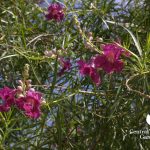Chinaberry tree at my new house: should I remove?
Thanks to Robyn Squyres for this great question and picture! Recently, she bought a house and is starting a wildlife garden. Unfortunately, the house came with one of my worst nightmares: a large chinaberry tree in the backyard.
Robyn’s concerned about it, since she knows that it’s an invasive species. She’s already pulled up two chinaberry seedlings.
On the other hand, it does provide shade and the birds do love it. Should she cut it down now? Or, should she plant a sapling underneath to grow up a few years before removing the chinaberry?
Something else to consider: chinaberry is toxic to dogs.
Although I usually don’t recommend complete removal of a mature tree, even an unwanted one, before you can plant another one and get it well on its way, in this case, that is exactly what she should do.
I’m normally not a reactionary to many of the plants listed as “invasive species.” The “invasive” nature of some plants is in the eye of the beholder. An aggressive nature, in the right spot, could be a benefit, since “aggressive” plants are pretty tough in the face of adversity, for example, our extreme drought and heat of the last few years.
It also depends on the planting location, and its proximity to water and natural areas. No species listed as invasive should be planted in landscapes that abut any greenbelt spaces, streams, or other nature-spots.
But Chinaberry is invasive no matter where it’s planted, thanks to birds that scatter the seeds.
Final recommendation: Cut it down!
Then, be prepared to fight a fierce battle with seedlings and root sprouts. The only answer to keeping the tree from returning is vigilance and sweat equity. Also, check with an arborist to have the large stump ground out.
Check out Texas Invasives’s plant database for other invasive plants.








 Daphne Richards
Daphne Richards Invasive Plant Alternatives
Invasive Plant Alternatives Trisha Shirey
Trisha Shirey